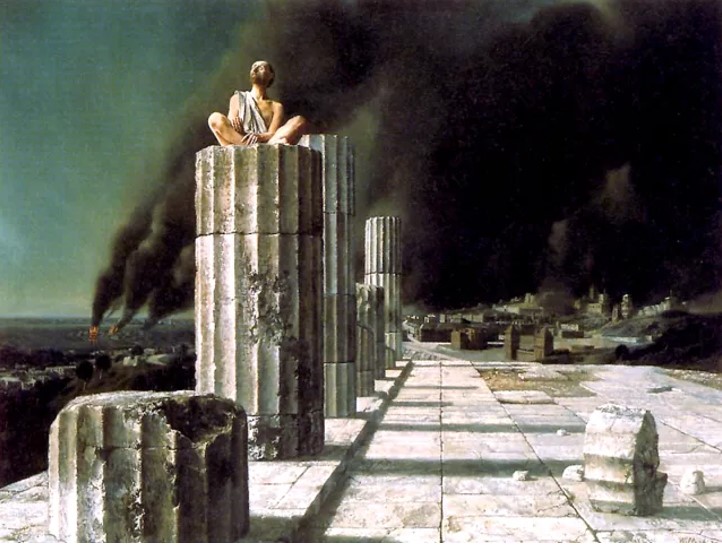Willink, Carel - VM - Willem de Vink
Carel Willink: Simeon the Stylite

Pray for the World
by Willem de Vink
“Willink is not aware that he himself is the kind of man who watches the world without getting involved,” was one of the reactions when the Dutch painter Carel Willink disclosed his painting Simeon the Stylite in 1939. “That is very well possible,” he replied, “painting is indeed what you cannot express in words.” His answer is illustrative for his imperturbable way of working. While many talented artists distanced themselves from the ‘natural’ and the ‘object’ and embraced abstraction, Willink kept on making figurative art, in which he aimed for utter perfection. He gained many admirers and in the Dutch town of Ruurlo, in Gelderland in the eastern part of The Netherlands, there is a whole museum dedicated to his work.
I saw his paintings for the first time when in high school. My art teacher took me along to an exhibition of Magic Realist artists in Antwerp. Willink’s art was incorporated in that stream of art as it exhales a sense of indeterminacy between fantasy and reality. He himself preferred to call it ‘imaginary realism’: reality painted from the imagination. This imagination continues to fascinate me. His godforsaken cities, streets and landscapes amaze me and I am surprised that in the midst of great disaster he painted himself as a preacher as in the painting above. “You should not take this in any way as religious,” he said. But all the same he did devote himself to the creation of this image of himself and had spent considerable time on the title.
Simeon the Stylite is a much discussed highlight in Willink´s oeuvre. We see a man who sits on top of a column in a colonnade destroyed by violence. Behind him dark clouds hang above a city caused by a fire that is still raging on. The evening sun casts long horizontal shadows on the ground. They are intersected by the lines of the tiles on the empty square. The perspective guides your eye towards the city; the painter has taken half of his canvas to lead your gaze in that direction.
The name of the work derives from church history. There were two ascetics who were called Simeon the Stylite or Simeon Stylites, an older and younger one. They lived in Syria in the fifth century, close to the present Aleppo. They were hermits, men who lived in isolation to pray and meditate. In between their prayers they gave advice to pilgrims. The elder one spent 39 years on a column, the younger one 69 years.
Willink said about this painting that he had seen a photograph of a city on fire that appealed to him. In his house at 15 Ruysdaelkade in Amsterdam he sat down on a table before a mirror, naked, with a sheet wrapped around himself. This way he became the pillar saint.
Willink made his Simeon in 1939. It is often regarded a prophetic work that made palpable the ominous atmosphere of an approaching world war. But Willink had already depicted many more of these impending scenes and continued to do so after even the war. Yet it was in precisely this painting that many commentators saw the existential angst and the yearning for transcendence that evidently Willink was attempting to embody.
This painting with its burning city reflects current events. And through the presence of the stylite it works like a mirror. It gives rise to the question how I relate to world events. What happens around me moves me and occupies my mind. But how should I react? Here I need help. Do I take the time to isolate myself to look up to heaven? Not to distance me from world, but to pray for its restoration?
*******
Further reading: Luke 19:41-44, Matthew 4:1-11, Matthew 6:9-13.
Carel Willink: Simeon the Stylite, 1939, oil on canvas, 56 x 76 cm. Gemeentemuseum, Den Haag, The Netherlands.
Carel Willink (1900-1983) was born on 7 March 1900 in Amsterdam in The Netherlands. His work is primarily associated with the Magic Realism style of art. Initially he studied medicine, then architecture, afterward deciding he wanted to be a painter and moving to Berlin to study. He experimented with various styles such as the Dada and New Objectivity (Neue Sachlichkeit) of George Grosz. For a time he also explored abstract art. On his return to Amsterdam in 1924 he had adopted a figurative style influenced by Picasso's neoclassical paintings of the 1920s. Inspired by the Italian painter Giorgio de Chirico, founder of the Scuola Metafisica that influenced the Surrealists, Willink developed his own particular style of deserted streets, squares and parks. He was also appreciated as a portraitist. Among his portraits are ones of beer baron Freddy Heineken and Queen Juliana of The Netherlands.
Willem de Vink, born in Utrecht, NL in 1957, is a Dutch speaker, writer, and artist and pastor who lives in Rotterdam. His comic book Jezus Messias (Jesus Messiah) has already been published in more than 200 languages. He also wrote the book Dit is liefde, Vincent, (This is love, Vincent). He recently published the book In het hoofd van de maker, Creativiteit, Kunst, Kerk (In the Mind of the Maker, Creativity, Art, and Church).
ArtWay Visual Meditation August 21, 2022


